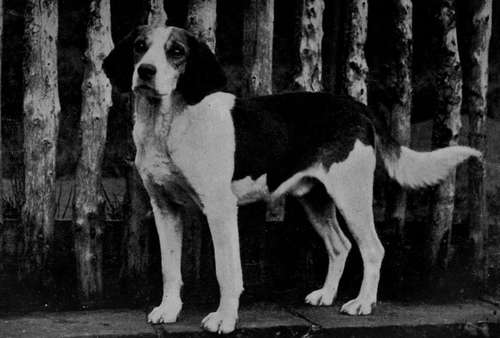Harriers
Description
This section is from the book "Sporting Dogs. Their Points And Management In Health, And Disease", by Frank Townend Barton. Also available from Amazon: Sporting Dogs; Their Points and Management in Health and Disease.
Harriers
Although there are packs of Harriers in various parts of the country, they are of a very limited number, hare-hunting with Hounds being a very inferior sport to that of fox-hunting. Moreover, hares are not as plentiful as in the days of our forefathers, in a large measure arising through diminished agricultural industry and commercial relations.
That good sport is still to be had with Harriers we do not for a moment dispute, but it is not general.
Formerly " dwarf " foxhounds were used for hare-hunting, though proved not to be equal to the typical Harrier for this purpose.
Harriers vary in their height according to the nature of the country they have to work in.

Lecturer—A Member of the Crickhowell Harriers.
From 16 to 20 inches is the general height sometimes a trifle more, or less.
Unless very carefully trained, Harriers will hunt rabbits, and then they are with difficulty broken of this vice.
The most useful colour is black, white and tan (tricolour), but hare, red, tan, badger and yellow pies are frequent.
Throughout, the Harrier should be symmetrical, have a large nose, dilated nostrils, ears low set on and lying close to the cheeks, and the neck long and strong. A short neck is a defective one.
There must be no loose skin, such as dewlap, etc., in this region.
Elbows well let down and carried in the same line as body.
Loins
Broad; and back straight, strong, and wide.
Back Ribs
Deep.
Chest
Deep, but not wide.
Fore Limbs
Straight as a line, well rounded and of good bone and substance. Feet must be hard and compact.
Strong hind-quarters, and a gay carriage of tail are typical of a well-built Harrier.
Coat
Dense, smooth (not coarse), and glossy.
Twenty couples were considered by the late Peter Beckford as constituting a full pack of Harriers, though there is no fixed number for this purpose.
Our illustration represents one of the Crickhowell Harriers, and for the picture I am indebted to Mr Stanhope Lovell of Crickhowell.*
Continue to:
